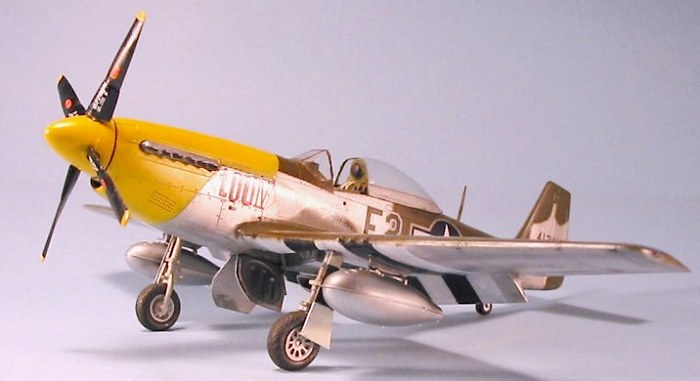
|
KIT: |
Tamiya 1/48 P-51D Mustang |
|
KIT # |
61040 |
|
PRICE: |
$26.00 MSRP |
|
DECALS: |
3 options |
|
REVIEWER: |
|
|
NOTES: |

|
HISTORY |
One of these is the question that roils WW1 modeling groups about once a year: did Voss' Fokker F‑1 have a yellow cowling and rudder, or did it have an olive green cowling and white rudder? (Those who care to vote the former may join the line to the right that leads to the window you must jump out of, now.)
The other such question is: did the P‑51s of the 361st Fighter Group in the summer of 1944 have green or blue camouflaged upper surfaces, and if they did, which ones had what color? I have seen good friends stop speaking to each other over this issue.
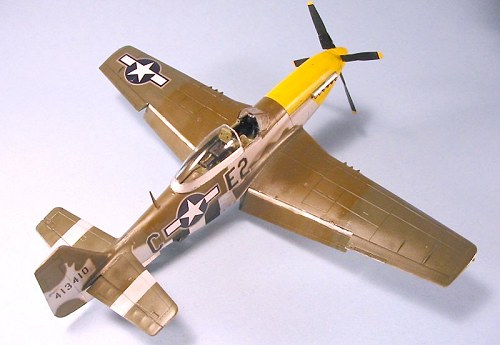 All this sturm und drang begins with a series of
photographs taken of four aircraft of the 361st sometime in
July, 1944. Interest among modelers has always been focused on these
shots because they are among the few photos taken during World War II in
color. One could almost wish they were in the then-standard
black-and-white, since they would have generated less controversy. This
controversy swirls particularly around the P-51 flown by the group
commander, LCOL Thomas J.J. Christian, which was certainly the most
colorful of the four aircraft.
All this sturm und drang begins with a series of
photographs taken of four aircraft of the 361st sometime in
July, 1944. Interest among modelers has always been focused on these
shots because they are among the few photos taken during World War II in
color. One could almost wish they were in the then-standard
black-and-white, since they would have generated less controversy. This
controversy swirls particularly around the P-51 flown by the group
commander, LCOL Thomas J.J. Christian, which was certainly the most
colorful of the four aircraft.
The problem revolves around the aging of color negatives and the color shifts that naturally occur, the different results that can be obtained through use of different filters, questions of what colors a fighter group might have used at which period of the war, whether to accept the testimony of members of the group over that of four young English “spotters,” ad nauseam.
This controversy has been made even more prominent over
the years by warbird owners who have restored their airplanes in one
variation or another of the two schemes, with varying aesthetic results.
Back in the 1970s, one warbird was restored as Christian’s “Lou IV” with
a very beautiful Royal Blue scheme, while another - owned by EAA founder
Paul Poberezny - was painted in a darker blue as “Paul I”. At about the
same time, Urban Drew - a leading ace of the 361st and one of
the pilots in the photo - stated categorically that the airplanes of the
group were painted with Olive Drab on their upper surfaces. Several
other surviving members of the group agreed with this, while four English
“airplane spotters” - one of whom went on to become the well-known
aviation historian Michael J.F. Bowyer - stated that they had seen these
aircraft, and they were painted blue. 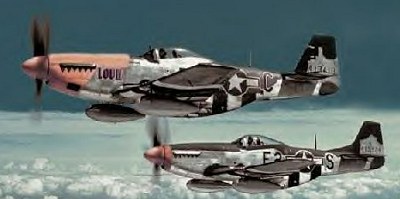
Who to believe? All the controversy stems from this picture.
Well-known aviation color historian Dana Bell comes down quite solidly on the side of the blue Mustangs. His argument is as follows:
1. British spotters: Most compelling is the fact that at least four wartime spotters, on separate occasions, independently recorded blue upper surface colors on 361st Mustangs. M.J.F. Bowyer was among the witnesses, and he has seen the other notebooks. While several vets have denied the use of blue, I consider it more likely that some would forget a color than those spotters would independently invent it.
2. Color photos. I dealt with the surviving USAF color originals for over 20 years. I never felt that they showed a definite blue color, but they clearly showed some aircraft to be a different shade than the green which is clearly visible on other aircraft in the same shots. It is clear that if there's a blue in those photos, it is not the same bright blue that appears on present-day restorations/warbirds.
3. Use of blue by other units. There is an ongoing argument that it made no sense to use blue camouflage; yet there is no argument that the 56th FG used blue on some of its P-47s. Remember, the main reason that paint was being added in June 44 was to cover the upper surface Invasion Stripes - nearly anything would do the job.
Allow me to disagree with my good friend Dana on each point.
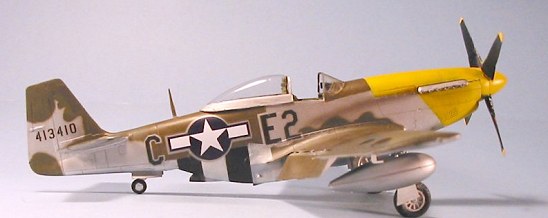 As to the British Spotters, I would want to know what the
sky conditions were on the days they observed these airplanes. I say
that because, as an aviation photographer for the past 30 years who has
shot airplanes in color, I can attest to the fact that sky conditions -
the presence or absence of clouds, the amount of the sky covered by
clouds, etc. - can have a truly astounding effect on the “color” of an
airplane when viewed by either the camera or the human eye. I often
marvel at a print I have, from a slide I took, of Bob Hoover's yellow
P-51D against what looks like a “magenta” sky (it was cloudy and overcast
that morning as I aimed the camera up), with a purplish-pink
airplane center frame!! Trust me, that was a yellow airplane. Given
that the usual condition of the British sky is overcast to one degree or
another, I believe that a dark “blue-base” green could easily look “blue”
to the untrained observer (and - as a former juvenile “airplane spotter”
myself, I can attest to the fact that while we may have been
knowledgeable, we were never “trained observers.”) No one can say one
way or the other what the sky looked like on the days these spotters saw
what they say they saw. Thus, the evidence is at best “indecisive.”
As to the British Spotters, I would want to know what the
sky conditions were on the days they observed these airplanes. I say
that because, as an aviation photographer for the past 30 years who has
shot airplanes in color, I can attest to the fact that sky conditions -
the presence or absence of clouds, the amount of the sky covered by
clouds, etc. - can have a truly astounding effect on the “color” of an
airplane when viewed by either the camera or the human eye. I often
marvel at a print I have, from a slide I took, of Bob Hoover's yellow
P-51D against what looks like a “magenta” sky (it was cloudy and overcast
that morning as I aimed the camera up), with a purplish-pink
airplane center frame!! Trust me, that was a yellow airplane. Given
that the usual condition of the British sky is overcast to one degree or
another, I believe that a dark “blue-base” green could easily look “blue”
to the untrained observer (and - as a former juvenile “airplane spotter”
myself, I can attest to the fact that while we may have been
knowledgeable, we were never “trained observers.”) No one can say one
way or the other what the sky looked like on the days these spotters saw
what they say they saw. Thus, the evidence is at best “indecisive.”
Color Photos: As Dana says: “I dealt with the surviving
USAF color originals for over 20 years. I never felt that they showed a
definite blue color, but they clearly showed some aircraft to be a
different shade than the green which is clearly visible on other aircraft
in the same shots.” He is absolutely right about this - there are in fact
different colors on different airplanes here, and that has muddied the
water for analysts ever since. Not to mention that color negative film
and color slides can change color over the years. I have slides taken
only 25 years ago, with modern film stock, that have shifted
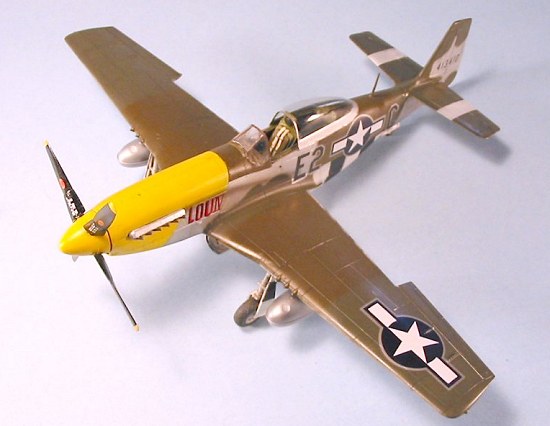 considerably
from the colors I know were present the day the picture was taken. For a
color negative or a color slide from 60 years ago to even be viewable is
amazing, and it is merely a matter of changing the order of the filters
in making a print to come out with a “blue” or a “green” subject. Again,
the evidence is indecisive.
considerably
from the colors I know were present the day the picture was taken. For a
color negative or a color slide from 60 years ago to even be viewable is
amazing, and it is merely a matter of changing the order of the filters
in making a print to come out with a “blue” or a “green” subject. Again,
the evidence is indecisive.
Use of blue as “camouflage” by other units. In the USAAF, the only other unit known for a fact to have used blue as “camouflage” is the 56th Fighter Group, and then only on their P-47Ms, which the unit flew between February 1945 and the end of the war. Given that the “camouflage color” or another squadron in the unit at the time was black, it is quite simple to see that this “camouflage” was more in the form of “unit heraldry” than it was actual camouflage. Considering that in the Spring of 1945, USAAF units in the ETO hardly had any reason at all for using “camouflage,” any use of blue here - as was done in the 63rd Fighter Squadron with their use of what was most likely Azure and Mediterranean Blue - which makes a very attractive look that has nothing whatsoever to do with real “camouflage” - is so far off-point when comparing this with a unit that was camouflaging its aircraft when the issue was still in doubt and the Eighth A.F. was urging its fighter units to adopt camouflage of their natural-metal-finish aircraft in light of a possible move to the Continent following the invasion, that the comparison is irrelevant. Look at every other 8th AF fighter group that brought back camouflage: they were concerned about hiding their aircraft on airfields in France. Blue is not a color one adopts to further such a goal.
And now, my own argument as to why there were no blue Mustangs in the 361st Fighter Group: Lt. Col. Thomas J.J. Christian would have come down on the man who made such a suggestion like the well-known “ton of bricks.”
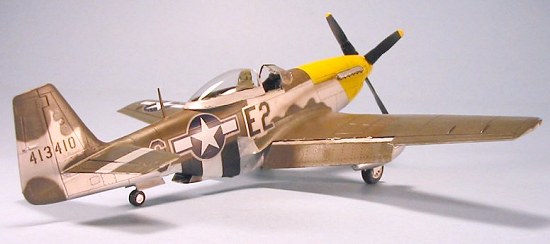 I am a writer of dramatic fiction, and as such, when I
create a character, I have to worry that that “person” will act like a
real person, i.e., with a certain consistency that can be defined as
“acting in character.” I've been doing this for over 20 years now; as
they say, “dramatic writers are observers of life,” and that I plead
guilty to. Any observation of the life of Thomas J.J. Christian will
demonstrate that agreeing to paint Mustangs blue would very definitely
not have been “in character.”
I am a writer of dramatic fiction, and as such, when I
create a character, I have to worry that that “person” will act like a
real person, i.e., with a certain consistency that can be defined as
“acting in character.” I've been doing this for over 20 years now; as
they say, “dramatic writers are observers of life,” and that I plead
guilty to. Any observation of the life of Thomas J.J. Christian will
demonstrate that agreeing to paint Mustangs blue would very definitely
not have been “in character.”
Consider: Christian was a pre-war USAAC pilot, and was described by at least one member of the 361st I have spoken to as “very G.I.” That was intended as a compliment. Christian was known as being a stickler for “the book.” That can be a good thing or a bad thing. Most members of the 361st remember him with respect - a good thing that comes from “going by the book.” Consider also that the 361st was not a “high-scoring” group. That is also the result of “going by the book,” the “book” in 1943 (when the group was founded) being that the role of fighters as escorts was to stick with the bombers and not act offensively in going after enemy fighters as they formed up. In fact, the practitioners of “offensive escort theory” fought long and hard, and were in the minority of fighter group commanders in the 8th AF. History may have proven the believers that “the best defense is a good offense” were right, but in 1943-44, Christian was right in the middle of the mainstream with his policy of defending the bombers through close escort and not going after the enemy offensively.
If one accepts that Christian is a “by the book” leader -
which he was - then looking at the relevant photographs takes on a
different dimension.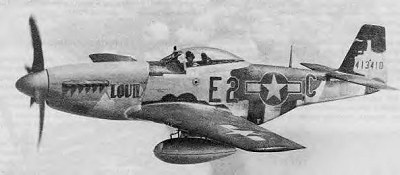
Look at this:
The important point (to me at any rate) is that the ETO ID stripe on the horizontal stabilizer can be seen, while the ID stripe on the upper wing is not present. One can also see from this (and more particularly from the color-corrected photo above) that there are two different colors on the upper camouflage of “Lou IV.” The darker color covers the outer wings and the tail, including the horizontal stabilizer. This color is likely the camouflage color applied to the airplane in the beginning, with the ID stripes applied (as called for). The lighter color - as seen here and in the other shot - covers that area of the fuselage and wing where the D-Day stripes would have been. They were overpainted, and there was not yet time to put the upper wing ID stripes on - which would fit with a late July photo date (as has often been stated), just as the upper stripes were being removed from allied aircraft..
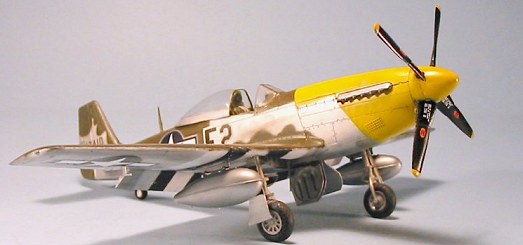 Go back up now and look at “E2*S”, the airplane that
almost all observers agree was in Olive Drab upper surfaces. This is a
P-51D-15 - the first sub-type with the dorsal fin extension - and by that
fact obviously an airplane that arrived in the unit later than the two
P-51D-5s without the fin extension. “E2*S” also obviously does not have
upper D-Day stripes overpainted, which confirms it as a recent arrival.
Go back up now and look at “E2*S”, the airplane that
almost all observers agree was in Olive Drab upper surfaces. This is a
P-51D-15 - the first sub-type with the dorsal fin extension - and by that
fact obviously an airplane that arrived in the unit later than the two
P-51D-5s without the fin extension. “E2*S” also obviously does not have
upper D-Day stripes overpainted, which confirms it as a recent arrival.
To me, as I look at this color-corrected print of the famous photo, what I see in “Lou IV” is an airplane originally camouflaged on its upper surfaces in British Dark Green, with the areas of the D-Day stripes overpainted in Olive Drab.
If Christian is the kind of officer I describe, then he would have wanted Olive Drab on his airplanes. In late May 1944, with the invasion due to happen anytime, there wasn’t time for that, so a good “book” officer would go with what’s available, and British Dark Green would have been an acceptable alternative. Later, when there’s time, the airplanes are painted in Olive Drab (E2*S), and the paint crews use that for the overpainting of the D-Day stripes. I can also offer that if you look at “Ferocious Frankie” from this group, a P-51D-5 in natural metal finish that was photographed with the upper area of the ID stripes painted Olive Drab, that you have a secondary confirmation.
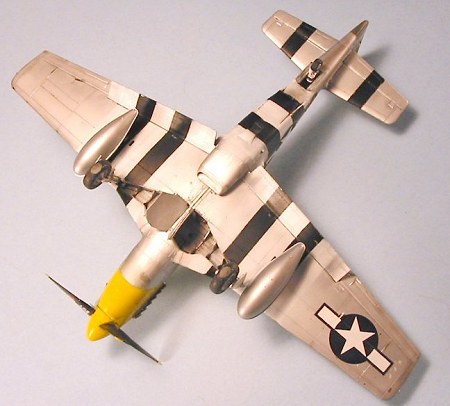 Interestingly enough, British Dark Green is a green that
has blue in it. U.S. Olive Drab is a color that faded rapidly at high
altitude under ultraviolet sunlight, and took on a distinct purplish
hue. Now, put an airplane with a blue-base green and a UV-faded Olive
Drab on its upper surfaces, as it comes down final approach to landing on
an English cloudy day (perhaps with a bit of rain threatening, as it does
in summer, which adds a blue cast to the dark clouds), and your 14 year
old “plane spotter” is not lying when he says “It was blue.” That's what
he saw.
Interestingly enough, British Dark Green is a green that
has blue in it. U.S. Olive Drab is a color that faded rapidly at high
altitude under ultraviolet sunlight, and took on a distinct purplish
hue. Now, put an airplane with a blue-base green and a UV-faded Olive
Drab on its upper surfaces, as it comes down final approach to landing on
an English cloudy day (perhaps with a bit of rain threatening, as it does
in summer, which adds a blue cast to the dark clouds), and your 14 year
old “plane spotter” is not lying when he says “It was blue.” That's what
he saw.
Can I prove any of this? I can prove that certain colors look certain ways in certain sky
conditions. I can show that other airplanes in this group are known to have had their D-Day stripes overpainted with Olive Drab. I can point to the fact that if one is going to base aircraft in Northern France and be worried about their vulnerability to being seen from the air and attacked while on the ground, logic would exclude any shade of blue as a useful “camouflage.” But that’s all just an “historical educated guess,” not matter how much can be demonstrated technically. To me, it comes down to the guy sitting in the cockpit of “Lou IV.” From all I can deduce about this guy, it just doesn't “fit” that Lt. Col. Thomas J.J. Christian would do something so “non-G.I.” - when “being G.I.” was what he was known for - as to paint his airplane blue.
Your mileage may differ.
|
CONSTRUCTION |
I have a policy that, when I have a well-built model, if it turns out that time has not been kind to the finish, or if better alternatives to markings come along, then that model is a prime candidate to head for the paint stripper shop, then to the paint shop for a new scheme. Given the price of models nowadays, and the fact that it's virtually impossible not to assemble a great model from either of the Tamiya P-51 kits, this policy makes good economic sense to me.
The other week, I was cleaning up the models, and realized that one of my P-51Ds was suffering. It was one of the first Tamiya P-51Ds I had built, some nine years ago when the kit first came out. My skills with the airbrush and knowledge of paint schemes was better now than it had been in those pre-internet days, and the finish had worn badly. During the same period that I made this discovery, the annual “blue Mustangs” debate erupted at HyperScale's discussion group, and included the posting of some useful photographs (most particularly, the color shot above, which has been color corrected properly). Going through the decal dungeon to inspect the residents, I noticed I had several of the original Tamiya decal sheet for the kit, which included the proper markings for this airplane (well, almost).
Strip A Kit: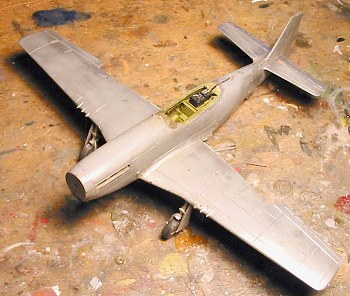
There are three ways to strip paint off a model. If you are one of those who thinks using oven cleaner is a viable option, perhaps you will want to read another article.
There are two good strippers available. Polly S “ELO” (Easy Lift Off) and Strip-A-Kit. If you use ELO, you have to be careful it doesn't eat the model; don't put it on for more than 10 minutes at a time, or you will find the plastic joints coming apart in strange (and not nice) ways. You can completely ruin a canopy by dipping it in ELO; other canopies will be fine - and the only way you will learn which is which is to “just do it.” I have used ELO many times, and likely will again. That said....
Strip-A-Kit may not work as quickly as ELO, and may require more applications to get down to bare plastic. But you will never ever have the model come apart at the joints, and there is no clear plastic that will craze if SAK is applied to it. SAK will not disassemble your model, as oven cleaner will do. In other words, your model is safe.
Need I say more as to which is the best to use?
After about 4 different applications of SAK (break through the varnish, hit the big areas, take off the paint below the decals, get rid of the paint in the difficult areas), the model was down to some left-over SnJ that wasn't going to come off without more work than was needed, since painting over the SnJ was easy to do.
|
CAMOUFLAGE & MARKINGS |
Painting:
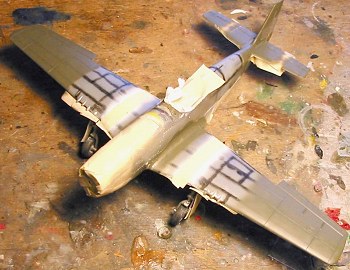 I started by pre-shading the model, which included
painting the areas of the black D-Day stripes, a bit wider than they
would be in the end. This makes painting white over the black difficult,
but the end result is the white looks “distressed,” which is the way
D-Day stripes should look, since they were not applied with permanent
paint. I also painted the area that would be yellow on the nose with an
undercoat of white at that point.
I started by pre-shading the model, which included
painting the areas of the black D-Day stripes, a bit wider than they
would be in the end. This makes painting white over the black difficult,
but the end result is the white looks “distressed,” which is the way
D-Day stripes should look, since they were not applied with permanent
paint. I also painted the area that would be yellow on the nose with an
undercoat of white at that point.
With the D-Day stripes masked off, I painted the yellow nose, then masked it off.
I then painted the fuselage sides and lower surfaces with
SnJ Aluminum. I painted the fabric elevators and rudder with Model
Master non-buffing Aluminum and sealed it, to show the fabric areas that
were painted with aluminum dope.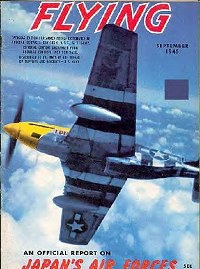
I then painted the upper surfaces of the tail and the
outer surfaces of the wing with Gunze-Sangyo “British Dark Green,” and
“UV-faded” it with a bit of Gunze-Sangyo “Dark Sea Grey” which has a
distinct purplish cast. I used the two photos of “Lou IV” that show left
and right sides to get the differences in
camouflage spray pattern. I then painted the areas where the D-Day
stripes were overpainted with Gunze Sangyo
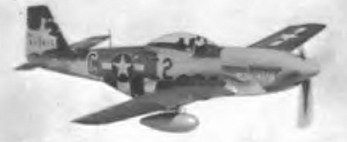 “Olive Drab 1", fading it with
some more of the “Dark Sea Grey.”
“Olive Drab 1", fading it with
some more of the “Dark Sea Grey.”
Once all this was unmasked, I painted the model with a good coat of Future. (Some of you sharp observers will have noted that I incorrectly masked off a white ID stripe on the upper wing. This was caught upon further review of the photos, and corrected before proceeding further.)
Decals:
I used the Tamiya silver backing for the upper surface national insignia, as well as the serial number and squadron codes. Only the “2" and the “C” have silver surround; I was able to do the proper surround to the “E” with some silver stripe decals. The Tamiya “Lou IV” name is too small - I used the “Lou IV” name from an old SuperScale decal, that being the only item of that sheet that was right for this model. I used national insignia from an older MicroScale P-51 sheet discovered in the decal dungeon.
|
FINAL CONSTRUCTION |
The photos show this airplane with a “semi-gloss” finish to the paint. Trust me, that wasn't the paint: it was automobile polish applied to the airplane by the ground crew. After a final coat of Future, I gave the upper surfaces a coat of Dullcote, followed by a light coat of Modelmaster Sealer, which gave the semi-gloss “waxed look” I was wanting.
I then reinstalled the exhausts, applied exhaust staining with Tamiya “Smoke,” and attached the 75-gallon metal drop tanks the real airplane was carrying when photographed.
|
CONCLUSIONS |
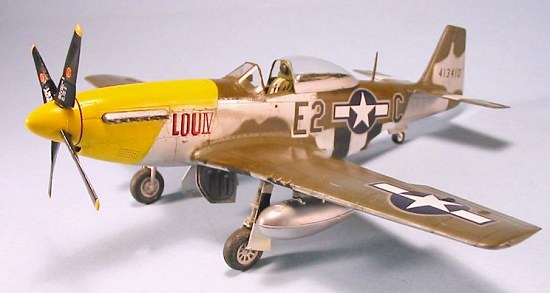 The model does not have the name that was applied to the
right hand side of the nose (which was NOT “Lou IV”!) Some day, someone
will issue those decals, I will apply that. In the meantime, it's
accurate markings-wise as I can get at the moment.
The model does not have the name that was applied to the
right hand side of the nose (which was NOT “Lou IV”!) Some day, someone
will issue those decals, I will apply that. In the meantime, it's
accurate markings-wise as I can get at the moment.
To me, this model looks like the photograph. Its colors fit logically with the decisions that would have been made by the CO of the 361st Fighter Group in the summer of 1944. It seems “right.” But then again, there are at least two “blue” 361st FG Mustangs out in the model museum at Planes of Fame, built by me. Like I said - your mileage may differ.
If you would like your product reviewed fairly and quickly by a site that has over 200,000 visitors a month, please contact me or see other details in the Note to Contributors.
Back to the Reviews Index Page